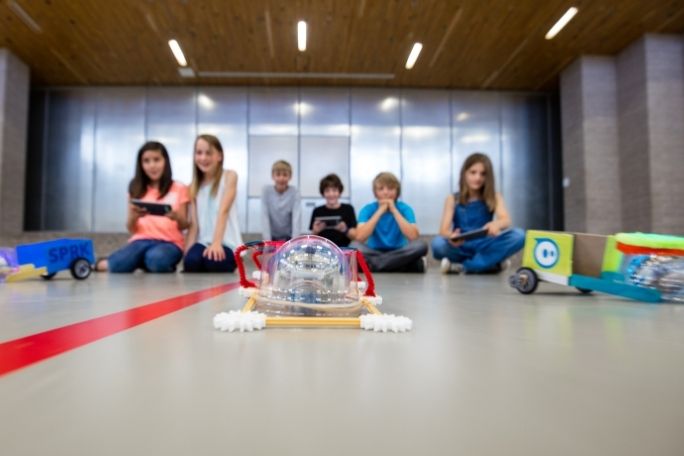Lesson summary
This is a STEAM lesson, which adds the Arts to STEM (Science, Technology, Engineering, and Mathematics). To find out more about STEAM and STEM click here. In this lesson, students continue to develop ideas for their project to engage their local community in robotics. They will conduct initial testing in collaboration with their peers and plan for testing with end-users and key stakeholders.
Learning intentions:
Students will...
- Students are able to develop ideas for robotics education activities based on peer and user-feedback
Success criteria:
Students can...
- create prototypes to share with others
- adapt their prototypes based on feedback
Lesson guides and printables
Lesson details
Curriculum mapping
Australian curriculum content descriptions:
This lesson can be used across multiple curriculum strands in addition to the Maths that has been listed below. In particular, this lesson could also provide opportunities for Digital Technologies and English.
Year 5 Mathematics:
- Plan and conduct statistical investigations by posing questions or identifying a problem and collecting relevant data; choose appropriate displays and interpret the data; communicate findings within the context of the investigation (AC9M5ST03)
- Acquire, validate and represent data for nominal and ordinal categorical and discrete numerical variables, to address a question of interest or purpose using software including spreadsheets; discuss and report on data distributions in terms of highest frequency (mode) and shape, in the context of the data (AC9M5ST01)
Year 6 Mathematics:
- Interpret and compare data sets for ordinal and nominal categorical, discrete and continuous numerical variables using comparative displays or visualisations and digital tools; compare distributions in terms of mode, range and shape (AC9M6ST01)
- Identify statistically informed arguments presented in traditional and digital media; discuss and critique methods, data representations and conclusions (AC9M6ST02)
Syllabus outcomes: MA3‑1WM, MA3‑3WM, MA3-18SP, EN3-1A, EN3-2A, EN3-8D
General capabilities: Literacy, Numeracy, Digital Literacy, Critical and Creative Thinking, Personal and Social Capability.
Cross-curriculum priority: Sustainability.
Relevant parts of Year 5 Mathematics Achievement Standards: Students pose questions to gather data, and construct data displays appropriate for the data.
Relevant parts of Year 6 Mathematics Achievement Standards: Students compare observed and expected frequencies. They interpret and compare a variety of data displays including those displays for two categorical variables. They interpret secondary data displayed in the media.
Unit of work: Learning Robotics – Years 5 & 6
Time required: 120 mins
Level of teacher scaffolding: Medium – some students may require support to sort and analyse their findings
Resources required
- Device capable of displaying video to class
- Student Worksheet (one copy per student)
- Sphero SPRK+ (or alternative programmable robot), minimum one per 3 students. Device capable of running Sphero Edu App, e.g. iPad, iPod Touch (or required software for your robot), one for each robot
- A variety of reusable construction materials and additional equipment to create contexts/challenges for robots (e.g. Duplo, blocks, rulers, tennis balls, small hoops, or craft construction materials)
Skills
- Collaboration
- Communication
- Community engagement
- Creativity
- Critical thinking
- Digital literacy
- Enterprise
- Problem solving
- Social skills
Additional info
Robotics:
Why should you teach robotics, you ask?
In his article Five reasons to teach robotics in schools, Leon Sterling suggests reasons to be:
- Children find it fun
- It is an effective way to introduce programming
- Skills developed are useful to future employment
- It suits children with a range of abilities
- It demystifies complex technology
These factors are also reiterated by the Digital Technologies Hub, developed to support Australia’s teachers to implement quality Digital Technologies programs in schools.
While it is hard to define exactly what a robot is, the fact is that robotic devices are now all around us. We have robots vacuuming our carpet, building cars - they are even beginning to drive cars. Therefore, developing an understanding of robotics, and the overlap between robotics and coding and programming, is important in supporting our students to develop skills for the 21st century.
STEAM Education:
Over recent years, the importance of STEM has been heavily promoted and discussed within fields of education. This has been within the context of ensuring that the next generation of students are provided with relevant knowledge and skills for the 21st century. STEM acknowledges the importance of the interrelated nature of science, technology, engineering and mathematics and the prominence of these skills in a world of continuous technological advancement.
What was missing from this original acronym, however, was acknowledgement of the vital importance of artistic and creative thinking. The ability to think outside the box to develop artistic and creative solutions.
Many figures involved in science and technological advancement (notably Leonardo DaVinci, Albert Einstein and Steve Jobs) valued and applied the contribution of artistic skill into their work. Art and design is also important in other industries such as marketing, advertising and promotion. The relevance of art is integral to success in all of the original STEM areas, and so STEAM education is now moving to the forefront.
This is an original Cool+ lesson.


Welcome back!
Don't have an account yet?
Log in with:
By signing up to Cool.org you consent and agree to Cool's privacy policy to
store, manage and process your personal information. To read more, please see
our privacy policy here(Opens in new tab).
Create your free Cool.org account.
Many of our resources are free, with an option to upgrade to Cool+ for premium content.
Already have an account?
Sign up with:
By signing up to Cool.org you consent and agree to Cool's privacy policy to
store, manage and process your personal information. To read more, please see
our privacy policy here(Opens in new tab).